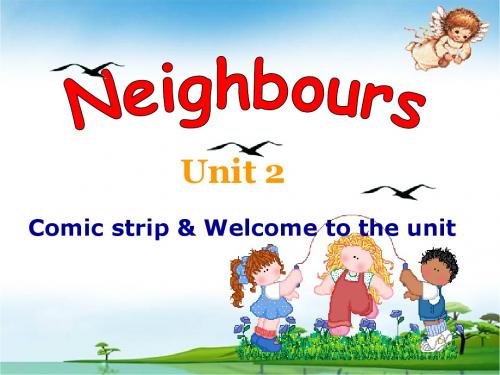7b unit2 neighbours welcome to the unit
- 格式:ppt
- 大小:4.29 MB
- 文档页数:18


新版⽜津英语7BUnit2neighbours完整单元教案7课时Unit 2 neighborsComic strip and welcome to the unit教学⽬标1、能识别并掌握各种职业及⼯作场所的名称。
2、能⽤简单的英语谈论⾃⼰所居住的社区。
教学内容四会内容词汇:neighbour will visitor like句型:I’m going to visit our new neighbours.三会内容词汇:wow waiter neighbourhood教学准备1、社区配套设施的图⽚。
2、从事不同职业的⼈的图⽚。
3、配套磁带或光盘。
教学步骤Welcome to the unitStep I复习1、教师向学⽣呈现⼀篇⽇记,让他们⽤场所的名称填空。
Tomorrow is Saturday. My family are all free. My parents do not need to work in their and I have no lessons at . So we decide to go outside to enjoy the weekend.In the morning, my father wants to visit the next to our building to have a look at some old things. My mother wants to buy clothes in some new near our home. I want to have a picnic with my friends in a .In the afternoon, my family will watch a film in a and have a big meal in a famous .What a wonderful weekend! Now it is time to go to the to buy something for tomorrow.(factories; school; museum; shops; park; cinema; restaurant; supermarket)2、与学⽣就个⼦的居住状况进⾏交流。

牛津译林版英语七下Unit 2《Neighbours》(welcome to the unit)教学设计一. 教材分析牛津译林版英语七下Unit 2《Neighbours》主要讨论了与邻居相关的日常交流用语。
通过本单元的学习,学生将能够掌握与邻居交流的基本用语,描述邻居的特点以及日常生活中与邻居的互动。
本单元主要包括以下几个部分:welcome to the unit、read and write、listen and say、look and say、task、self-check以及word bank。
二. 学情分析学生在进入七年级下学期时,已经具备了一定的英语基础,能够进行简单的英语听说读写活动。
但部分学生对于日常英语交流仍感到困难,特别是在实际应用中,可能出现表达不准确或胆怯的情况。
因此,在教学过程中,需要关注学生的个体差异,鼓励他们积极参与课堂活动,提高他们的自信心。
三. 教学目标1.知识目标:学生能够掌握与邻居交流的基本用语,描述邻居的特点以及日常生活中与邻居的互动。
2.能力目标:学生能够在实际情景中运用所学知识进行日常英语交流,提高他们的口语表达能力。
3.情感目标:学生能够学会尊重他人,培养良好的邻里关系。
四. 教学重难点1.重点:学生能够掌握与邻居交流的基本用语,描述邻居的特点以及日常生活中与邻居的互动。
2.难点:学生在实际情景中运用所学知识进行日常英语交流,特别是听力和口语能力的运用。
五. 教学方法1.情境教学法:通过设置各种与邻居相关的实际情景,让学生在情境中学习与练习英语。
2.交际教学法:鼓励学生积极参与课堂互动,进行真实的英语交流。
3.任务型教学法:通过完成各种任务,让学生在实践中运用所学知识。
六. 教学准备1.教师准备:提前熟悉教材内容,了解学生的学习情况,设计合理的教学活动和任务。
2.学生准备:预习教材内容,了解本单元的学习目标。
七. 教学过程1.导入(5分钟)教师通过提问方式引导学生回顾上一单元学到的内容,如家庭成员的称呼和特点。

课题:7B Unit2 Neighbours(Welcome to the unit )一、活动目标:1.1.Get the Ss to know jobs and names of working places.2.Talk about the neighbourhood you live in in English.3.Talk about the activities and life in your neighbourhood in English.二、重点、难点重点:Have a discussion in class, and talk about the jobs they know.难点:1.To talk about the neighbourhood they live.2.To discuss the neighbourhood they like.三、活动设计Ⅰ. Warm-upAsk the student to recall the jobs they learned.Ⅱ.ListeningListen to the tape, answer my question.1.Where does Simon live?2.How many buildings are there in his neighbourhood?3.What do they have around their neighbourhood?Ⅲ.Role-play1.Ask the Ss to talk about the neighbouthood they live in pairs.2.Ask the Ss to talk about the neighbourhood they like in groups.IV. Language points:1.I’m going to visit our new neighbours.Be going to do sth.= will do sth.e.g. They are going to have a party next week.= They’ll have a party next week.2.I’m afraid they won’t welcome visitors like you.like prep. “像…”It’s good to live in a ne ighbourhood like that.Ⅴ.Sum-upGo through the new words and the language points learn during this lesson.Ⅵ.Homework1.Review the contents of this lesson.2.Make a new conversation about the neighbourhood they live.四、教后反思1。


7B Unit 2 Neighbours第1课时Comic strip&Welcome to the unit预习目标1.根据单词表,预习课本第18~19页的单词,能根据音标正确拼读这些单词。
2.听课本Comic strip部分的录音,能正确地模仿对话中的语音和语调。
3.找出课本第18~19页新出现的短语和重点句型,猜猜它们的意思。
预学热身◆通过预习,了解本课时的单词、短语、句型(英译汉)。
1.neighbour n. _______ 2.wow excl._______3. will modal v._______4.visitor n._______5. like prep._______6.waiter n._______7. neighbourhood n._______ 8.in Ninth Street_______9.most of them_______10. - Where are you going? - I'm going to visit our new neighbours._____________________________________________________________________11. I'll meet them too! ________________________________________________________12. I'm afraid they won't welcome visitors like you.___________________________________13. I live in a flat in City Garden in Ninth Street.___________________________________14. Most of them have 14 floors.________________________________________________●自主探究,请带着下面这些问题阅读教材。
牛津英语7B Unit 2重点短语和句型一、短语Welcome to the unit1.I'm going to visit my new neighbours.我打算去拜访我的新邻居2.I'm afraid.恐怕3. What does she look like? 她长什么样子=What is she like?=How does she look?4.It's lucky to live in a neighbourhood like that. 居住在那样的社区很幸运5.It's good/lucky to do sth. 做某事好/幸运6.How many buildings are there in your neighbourhood?在你的社区有多少幢楼7.most of them/us他们/我们中的大部分8.around your neighbour在你的社区周围Reading1.What are your neighbours like? 你的邻居怎么样?2.What does your new neighbour like? 你的新邻居喜欢什么?3.They're kind and helpful. 她们善良且乐于助人4. at the community centre在社区中心5.share their different skills分享各自的一技之长6.help us with all kinds of problems帮助我们解决各种各样的困难7.help you with your homework帮助你做功课help sb with sth帮助某人解决某事help sb do sth帮助某人做某事8.have a “helping hands”meeting召开“助人为乐”会议9.have a meeting.开会10.There’s something wrong with sth某物坏(失灵)了=Something is wrong with sth.=something is broken坏了be broken=don't work well11.Nothing is wrong with sth某物没有坏=There is nothing wrong with sth.12.at/on the weekend=at/on weekends在周末this weekend本周末13.a computer engineer一位电脑工程师an engineer一个工程师14.ask sb to do sth叫、要求某人做某事ask someone to fix his bicycle请人修他的自行车15.check the computer检查电脑16.some college students一些大学生17.be ready to do sth乐意做某事They're ready to help others她们总是乐于助人18.do some shopping for them为他们采购些物品do some cleaning/reading/washing打扫卫生/读些书/洗衣服19.help the old people clean the flat帮助老人打扫公寓20.need help with sth在某方面需要帮助21. find someone to fix things like broken bicycles找人修理像坏自行车之类的东西22.among the volunteers在这些志愿者之间between the countries在两个国家之间23.People here are like a big family. 这儿的人就像一个大家庭。
《Unit 2 Neighbours》Welcome to the unit教案授课时间:年月日总计:课时教学目标:1. .Master the names of all kinds of jobs and working places.2. .Can talk their own towns in English.Teaching contents:Words: neighbour will visitor like wow waiter neighbourhoodSentences: I’m going to visit our neighb ours.教学重点:Words and phrases教学难点:Write sentences about what will do课时安排: 1 课时教学过程:复备栏Ⅰ. Step 1. review①In the afternoon, my family wil l watch a film in a andhave a big meal in a famous .What a wonderful weekend! Now it is time to go to the tobuy something for tomorrow.2. T: Where do you live? What kind of home do you have? What’saround your home? Is your home near a park/a school/a re staurant/a supermarket?Is there a shop/a factory/a cinema/a museum/ahospital near your home? Encourage the students to answer bythemselves.Step2. Presentation1.T: Who lives next to your flat/house? Who lives above/blow you?Who’s your n eighbour? Wha t’s your neighbour? What’s yourneighbour’s name? What does he/she do?Write ‘neighbour’ on the blackboard.2.T: Mr. Lin is my neighbour. He’s a waiter in a big restaurant. Miss Huang lives above me. She’s a teacher.Write ‘waiter’ on the blackboard.Step 3. Practice1.Ask the students to finish exe rci se A.T: We have a lot of neighbours. They have different jobs. Look at the pictures. Where do they work? Please match them with the places. 2.Make a dialogue with a student.Step 4. Presentation1.Make sure the understand the idea of the dialogue B.T: Amy is asking Simon questions. What are these questions about? Please listen to the tape and tell me.2.Encourage the students to the tape and answer.T: The questions are a bout Simon’s home and different places a round his flat.Present ‘neighbourhood’ and write it.Step5.Practise1.Play the tape ,ask the students to answer more questions. eg:(1)Where’s Simon’s flat?(2)How many buildings are there in neighbourhood?(3)How many floors do the buildings have?(4)What does Simon have around his neighbourhood?(5)What does Simon think of his neighbourhood?2.Divide the students into two groups to read.3.Ask some students to make a dialogue using part B as a model.4.Ask some students to act.Step 6. Presentation1.T: Do you often talk with our neighbours? Do you often play withyour neighbours? Do you like visiting them? Do they often visit your home? Do you thin k they’re good visitors? What do you think your neighbours?Write ‘visitor’ on the blackboard.2.ask the students to listen to the t ape and find the answer:Where’sHobo going?3.ask the students to answer more questions according to the tape. Step7.PractiseAsk the students to read the dialogue and act.Step8. Presentation1.Encouage the students to say their ideas acco rding to the comicstrip.2.Arrange the students to talk about and discuss:Wh at can you dofor your neighbours?Step9.Homework1.Remerber all the new words and sentences.2.Ricite the dialogue and part B.3.Finish the exercise.教学反思:。